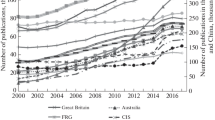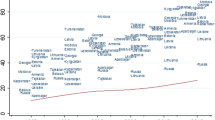Abstract
On January 1, 2015, the Republic of Armenia joined the (Russian-led) Eurasian Economic Union (EAEU) and actually refrained from entering into the alternative Association Agreement with the European Union (EU). Nevertheless, despite the prevalence of historic ties with the scientific community of the EAEU member-states and some push towards that direction, Armenian researchers demonstrate a certain scientific autonomy, which is expressed in numerous international scientific collaborations with researchers from many European countries. This paper proposes a bibliometric analysis of the international scientific collaboration between (i) Armenia and EU countries, and (ii) Armenia and EAEU countries, based on the papers indexed by the Web of Science Core Collection database and the Russian Science Citation Index database. Results indicate that the international collaboration with researchers from countries of both blocks gradually grows, displaying similarities and differences. Globally, Armenian researchers seem to collaborate more with researchers from EU countries rather than EAEU countries. Despite this, individual collaborations with Russia continue to prevail over those with other individual European countries, primarily Germany. Finally, it has been noted that “megaprojects” significantly influence the scientific collaborations between Armenian and foreign researchers.









Similar content being viewed by others
Notes
The Soviet Union was dissolved on December 26, 1991; as a result the following fifteen states “appeared” on the world political map: the Republics of Armenia, Azerbaijan, Belarus, Estonia, Georgia, Kazakhstan, Kirgizstan, Latvia, Lithuania, Moldova, Russia, Tajikistan, Turkmenistan, Ukraine and Uzbekistan.
The CIS was founded on December 8, 1991 when Belarus, Russia and Ukraine signed the “Agreement Establishing the Commonwealth of Independent States”, concerning the new relations between these nations after the Soviet Union dissolution.
Ukraine and Turkmenistan are CIS associate members. In 2008 Georgia withdrew its membership from CIS. Then, Ukraine also announced its intention to withdraw CIS.
The Collective Security Treaty Organization (CSTO) was signed on May 1992. The CSTO member states are: Armenia, Belarus, Kazakhstan, Kirgizstan, Russia and Tajikistan.
The Customs Union was founded in 2011 and was reorganized into the Eurasian Economic Union in 2015. Member states are Russia, Belarus, Kazakhstan, Armenia and Kyrgyzstan. .
The European Union (EU) is a political and economic union of several member states, which was established in 1993.
The European Neighborhood Policy (ENP) was launched in 2004 based on “Wider Europe—Neighborhood” Communication, with the aim of achieving close political association and economic integration with EU’s sixteen Eastern and Southern Neighbors: Algeria, Morocco, Egypt, Israel, Jordan, Lebanon, Libya, Palestine, Syria, Tunisia, Armenia, Azerbaijan, Belarus, Georgia, Moldova, Ukraine.
The Eastern Partnership (EaP) is a joint initiative of the EU member states and six Eastern European partners: i.e., Armenia, Azerbaijan, Belarus, Georgia, Moldova and Ukraine, based on a commitment to the principles of international law and fundamental values of democracy, the rule of law, human rights and fundamental freedoms. It also supports market economy, sustainable development and good governance.
The Association Agreement is a bilateral agreement between the EU countries and third countries, representing a basis for the implementation of the admission process to the EU.
For more information on the bilateral projects organized by the State Committee of Science, see https://scs.am.
With “AM+EU” we denote articles that include (at least) one Armenian researcher and (at least) one from EU.
With “AM+EAEU” we denote articles that include (at least) one Armenian researcher and (at least) one from EAEU.
Within this article we refer to “megaprojects” as projects involving more than ten partner organizations.
This indicator, taken from the WOS InCites Essential Science Indicators database, is defined as “the number of papers in the top 1% of papers for the past 10 years, and the number of papers of the past 2 years, which received a very high number of citations in the 2-month period”.
The WOS CC database allowed identifying the groups of authors and then the corresponding megaprojects. On the other hand, the RSCI database does not have a tool to do this; for this reason it is not used in this part of the analysis.
These numbers reflect the number of times any country appears as a collaborating country in the database.
References
European Statistical Office (Eurostat). Retrieved July 20, 2019, from https://ec.europa.eu/eurostat/data/database.
Finardi, U. (2015). Scientific collaboration between BRICS countries. Scientometrics,102(2), 1139–1166. https://doi.org/10.1007/s11192-014-1490-5.
Franceschini, F., Maisano, D., & Turina, E. (2012). European research in the field of production technology and manufacturing systems: An exploratory analysis through publications and patents. The International Journal of Advanced Manufacturing Technology,62(1–4), 329–350.
Glänzel, W., & Schubert, A. (2003). A new classification scheme of science fields and subfields designed for scientometric evaluation purposes. Scientometrics,56(3), 356–367.
Glänzel, W., & Zhang, L. (2018). Scientometric research assessment in the developing world: A tribute to Michael J. Moravcsik from the perspective of the twenty-first century. Scientometrics,115(3), 1517–1532.
Glukhov, V. A., Gzoyan, E. G., & Sargsyan, S. A. (2017). Assessment of scientific cooperation between the scientists from Armenia and Russia within the Joint bilateral grant projects. Sotsiologicheskieissledovaniya [Sociological Studies],7, 156–158.
Gzoyan, E., Hovhannisyan, L., Aleksanyan, S., Ghazaryan, N., Hunanyan, S., Bourghida, A., et al. (2015). Comparative analysis of the scientific output of Armenia, Azerbaijan and Georgia. Scientometrics,102(1), 195–212.
Melin, G., & Persson, O. (1996). Studying research collaboration using co-authorships. Scientometrics,36(3), 363–377.
Mikhailov, O. V. (2013). Russian science citation index. The opinion of an interested user. Herald of the Russian Academy of Sciences,83(3), 292–296.
Moskaleva, O., Pislyakov, V., Sterligov, I., Akoev, M., & Svetlana Shabanova, Sh. (2018). Russian index of science citation: Overview and review. Scientometrics,116(1), 449–462.
Nagpaul, P. S. (2003). Exploring a pseudo-regression model of transnational cooperation in science. Scientometrics,56(3), 403–416.
UNESCO. (2016). Science report towards 2030.
Vinokurov, E. (2017). Eurasian economic union: Current state and preliminary results. Russian Journal of Economics,3(1), 54–70.
Wang, L., Wang, X., & Philipsen, N. J. (2017). Network structure of scientific collaborations between China and the EU member states. Scientometrics,113(2), 765–781. https://doi.org/10.1007/s11192-017-2488-6.
Zitt, M., Bassecoulard, E., & Okubo, Y. (2000). Shadows of the past in international cooperation: Collaboration profiles of the top five producers of science. Scientometrics,47(3), 627–657.
Acknowledgements
This work was made possible by a research Grant (soc-4767) from the Armenian National Science and Education Fund (ANSEF), based in New York, USA.
Author information
Authors and Affiliations
Corresponding author
Rights and permissions
About this article
Cite this article
Sargsyan, S.A., Maisano, D.A., Mirzoyan, A.R. et al. EU-EAEU dilemma of Armenia: Does science support politics?. Scientometrics 122, 1491–1507 (2020). https://doi.org/10.1007/s11192-019-03337-z
Received:
Published:
Issue Date:
DOI: https://doi.org/10.1007/s11192-019-03337-z




